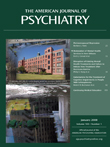Drs. Otte and Whooley Reply
To The Editor: We appreciate the thoughtful comments by Mr. Bayles et al. on our recent article. We agree that sympathetic nervous activation may contribute to the development of left ventricular hypertrophy and that this could be a potential mechanism by which s allele carriers of the 5-HTTLPR might be at increased risk for worse cardiovascular outcome. However, in our cohort there were no differences between s allele carriers and l/l homozygote subjects with regard to left ventricular hypertrophy, defined as a left ventricular mass index >90 g/m 2 by echocardiography (202/383 [54%] of s allele carriers vs. 99/174 [59%] of l/l homozygote subjects). Further, both groups did not differ in functionally relevant variables, such as left ventricular ejection fraction (s allele carriers: mean=62% [SD=10] vs. l/l homozygote subjects: mean=61% [SD=10]) and wall motion score (s allele carriers: mean=1.2 [SD=36] vs. l/l homozygote subjects: mean=1.2 [SD=33]), an index of ischemia. This suggests that greater 24-hour urinary norepinephrine in s allele carriers did not contribute to left ventricular hypertrophy in this study. However, as Dr. Bayles et al. correctly point out, human sympathetic nervous system activity is regionalized, with the outflow to some organs, such as the heart, sometimes being preferentially activated. Indeed, 24-hour urinary norepinephrine as a broad measure of overall sympathetic nervous system activity might lack the sensitivity to detect associations between sympathetic nervous activity and regional processes, such as the development of left ventricular hypertrophy. Given the large number of participants in our epidemiological cohort study, we were unable to use more localized measures of norepinephrine, such as cardiac catheterization techniques coupled with norepinephrine isotope dilution methodology. However, we agree that it would be an interesting next step to examine the association between HTTLPR and bimodal sympathetic activation in depressed patients (1). Certainly, much more work has to be done to elucidate the mechanisms by which 5-HTTLPR, depression, stress, and catecholamine secretion are linked and how they might affect outcome in cardiovascular disease.



